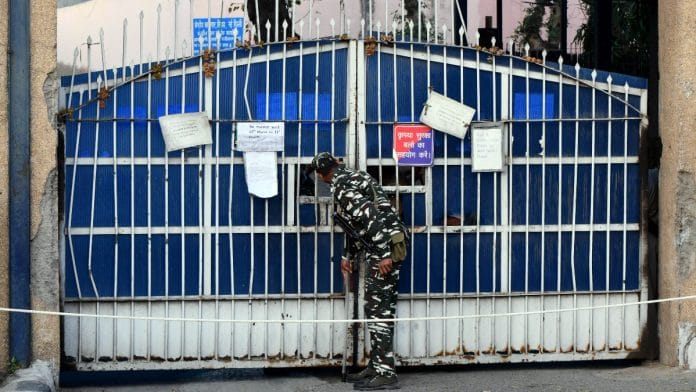New Delhi: Limited use of liberal bail provisions for women and the sick, detention of mentally ill undertrials despite statutory safeguards, continued incarceration of prisoners for offences that had less than seven years as punishment — these are among the many reasons why jails in India are congested.
The findings were part of an affidavit submitted by the National Legal Services Authority (NALSA) to the Supreme Court in a matter where the top court is aiming to work out a mechanism to decongest jails. The case, pending before a bench led by Justice B. R. Gavai, was filed by human rights activist Suhas Chakma.
According to the affidavit, the legal aid body’s findings were based on its analysis of the annual data provided by Undertrial Review Committees (UTRC), which recommends release of undertrials from jails, according to Supreme Court guidelines.
NALSA has designed the standard operating procedure (SOP) for UTRCs to make these recommendations. The affidavit stated that UTCRs have suggested release of more than three lakh prisoners since 2019. But a little over 1.52 lakh had been set free. The undertrials listed for release were selected irrespective of their background or their ability to get legal assistance.
NALSA’s observations on the judiciary’s ‘reluctance’ to grant bail to eligible undertrials comes at a time when the Supreme Court has on various occasions expressed its angst at high courts and trial courts for denying bail even in fit cases. In its recent judgment in the Manish Sisodia matter, the top court reminded them that “bail is the rule and jail an exception”.
The statutory body’s affidavit mentioned the services it has rolled out to make legal aid accessible to jailed undertrials and convicts. Its SOP for UTRCs was part of this exercise.
How undertrials eligible for bail are identified
According to existing guidelines, UTRCs send a list of undertrials who are eligible for bail to the District Legal Services Authority (DLSA).
The DLSA is supposed to apprise the undertrials about this. Those who can afford an advocate make their own arrangements, while poor undertrials are given legal aid by the DLSA concerned.
An analysis of data received from state UTRCs revealed multiple factors for prolonged incarceration of undertrials. In 2019, UTRCs suggested the release of over 37,000 inmates, but only 12,478 were let off.
In 2020 only 15,273 undertrials were released of the 28,357 recommended. In 2021, that number was 17,000 out of 36,983, while in 2022 fifty percent of the 70,780 recommendations were freed. Last year, the UTRCs suggested release of 50,669 inmates, but only 26,226 got bail.
According to NALSA, undertrials have not been released even though they were eligible for statutory bail under the outdated Criminal Procedure Code (CrPc). This law said accused who have served half the maximum punishment for the offence should be given bail.
Further, those suffering from mental illnesses were also in detention despite statutory safeguards prescribing their release. The affidavit also pointed out that people arrested for offences that carried less than seven years of punishment remained in detention despite Supreme Court directives on bail.
In addition, it cited limited use of liberal bail provisions for women, the sick or infirm and the failure to comply with Section 41A of the now-repealed CrPc behind the overcrowding. Section 41A stipulated that a notice be issued for appearance before a police officer in cases where a person’s arrest was not required.
Why the gap between undertrials identified & number recommended for release
NALSA’s study also found “unintended lapses” in the identification of prisoners whose cases need to be reviewed in the event they did not file their bail petitions. Speaking to ThePrint, a NALSA official said that in its limited role, a UTRC can only give suggestions. “Ultimately, it’s up to the undertrial to file the application and for the court to grant it,” he said.
On the gap between the total number of people identified and the number recommended for release, NALSA said this could also be on account of the variation in methodology adopted in different states for the identification of prisoners.
To enhance the efficiency of UTRCs, NALSA has come up with a quarterly schedule for them, apart from directing DLSAs to conduct an orientation session for their jail-visiting lawyers and paralegal volunteers to identify and report cases eligible for bail.
Speaking to ThePrint, senior advocate Vijay Hansaria who is assisting Justice Gavai’s bench, said: “Legal aid agencies have to be diligent in their exercise to identify undertrials who can be released on bail. Once UTRCs submit their list, the legal aid authorities should follow it up with a review of each case to know whether bail applications have been filed or not.”
He added: “If bail applications are rejected the legal aid authorities must follow it up to ascertain the reasons and be consistent with their approach.”
(Edited by Tikli Basu)






